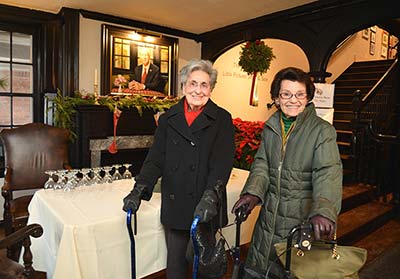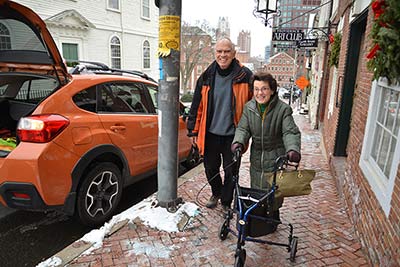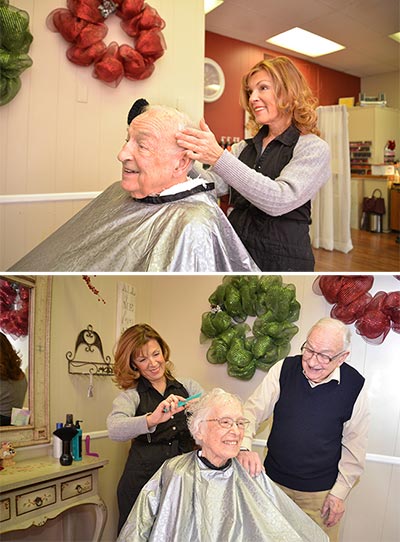Neighbors Helping Neighbors
Photos by Susan E. Bouchard
Lois and Preston Atwood, married for 71 years, share a laugh with Linda Ciolfi, a volunteer driver, as they head to an East Providence salon for haircuts before Lois’ 94 th birthday party.Across town, Marilyn Roberts puts out a plate of cookies and pours some sarsaparilla into a glass for volunteer Peter Viner-Brown before he gets to work assembling her new couch.Nan Levine and her friend Judith Litchman chat easily in the entranceway of the Providence Art Club while they wait for a ride home from a small luncheon with friends.

Nan Levine and her friend Judith Lichtman chat in the entranceway of the Providence Art Club.
Nan Levine and her friend Judith Litchman chat in the entranceway of the Providence Art Club.
The threads tying these active older adults together are part of the rich tapestry they became part of when they joined the Providence Village.
The Providence Village of Rhode Island is loosely based on a concept that first began in the Beacon Hill neighborhood of Boston in 2002. It is a grassroots, community-based, non-profit network of support for people who want to stay active in their communities as they grow older.
“It is like having this very extended neighborhood connection,” said James Maxwell, president-elect and one of the early members of the Providence Village.
Village members can receive help with transportation, health and wellness, simple home repairs, and support with technology. They also participate in many social and educational activities.
The Village transportation services far surpass those offered in many communities, as they aren’t limited to doctors’ appointments. Volunteers take their passengers anywhere they need to go.
Nan Levine and her friend Judith Litchman are helped to the car by volunteer driver Tony Allen after a small luncheon with friends.

Nan Levine and her friend Judith Lichtman are helped to the car by volunteer driver Tony Allen after a small luncheon with friends.
All requests are treated equally, because they are all equally important to the members, said Kathleen Harrington, member services coordinator.
“People would rather go to their local store and see people they know,” Harrington said. “Getting out of the house is what keeps people independent and a part of the community.”
The Providence Village service area comprises neighborhoods in both Providence and Pawtucket, within the confines of the Seekonk River and Routes 95 and 195. Recently, the Village expanded to include downtown Providence and the Woodlawn neighborhood of Pawtucket, said Martha Wales, a member of the Village Board of Directors.
The Village is a non-profit group run by volunteers and a small paid staff. Individual members pay $40 a month and couples pay $60, but they also have a pay-what- you-can option, Wales said. If you do not live within the current Village service area, you can still become an associate member. That fee is $20 a month and includes many of the services and enrichment activities, except transportation and in-home technical support and maintenance, she added. Anyone can become a volunteer.
It Takes a Village
The Village’s goal is to be a touchstone for members to remain independent, find friendship and receive support.
For Roberts, a strong and artistic retiree who moved to Rhode Island after leaving her job in publishing, membership has done just that.
“It changed my life,” she said. “It gave me back my freedom.”
Roberts is fiercely independent, so relying on bus schedules or asking family members for help was extremely limiting.
“Having someone drive me around is a very wonderful thing,” she continued. “This isn’t about doctor’s visits.” Volunteers have brought her to the mall, to visit a friend or to run errands. Beyond that, Roberts has benefited from the home maintenance service. “They don’t just run in and hammer a nail,” she said. “They call back and check on how things are.”
Marilyn Roberts shares a laugh with volunteer Peter Viner-Brown as he adjust the height of her new couch.

Marilyn Roberts shares a laugh with volunteer Peter Viner-Brown as he adjust the height of her new couch.
It’s also given her a real friendship with Viner-Brown, who has assisted Roberts several times to help with home projects she cannot manage alone.
The Village home program includes tasks such as changing a bulb in a hard-to- reach light fixture, hanging heavy items such as a shelf or picture frame on a wall, small furniture repair or assembly, and even some small home repair projects.
Harrington said the Village is partnering with an occupational therapist to create a home safety checklist. Volunteers, at the members’ request, will be able to check members’ homes for safety issues and even work with local contractors to ensure the work is done properly and cost effectively. A large part of Harrington’s job is making sure the volunteers, who are either members themselves or from the community at large, find just the right area to lend a hand.
“One of the best things about my day is watching what our volunteers are willing to do,” Harrington said.
Volunteers take their role in helping create an age-friendly community seriously. Viner-Brown, shared that many of the people he has helped don’t want to be a burden to anyone, they just want to be able to stay in their homes.
“To be able to help someone with that is a great feeling,” he continued. “It is great all-around for society.”
Ciolfi still works full time, but volunteers as a driver for the Village as often as she can. “I see it as paying it forward,” Ciolfi said. “It is an important part of what makes a community. I think it is a vital service.”
She also enjoys the interesting stories of those she’s met and creating friendships, such as the bond she’s formed with the Atwoods.
Since the Village is volunteer driven, it has an extensive screening process. Harrington oversees each team, provides training, and clears the volunteers’ driving records and background checks. Having that safety component put Roberts’ mind at ease, knowing the person she was opening her door to was trustworthy.
Remembering how she decided to join the Village, Roberts recalled with a laugh, “They interviewed me, and I interviewed them. It’s been a great fit.”
A Little History
In the spring of 2014, a group of nine people, who didn’t previously know one another, were drawn together around the idea that a supportive community could make a difference in their lives as they grew older. That fall, they did a survey of people in the community asking what they might want from a village. Using that information, they came up with a plan to launch the initiative.
Two years later, the Providence Village community has grown to about 115 members and 70 volunteers and continues to expand guided by its core values of generosity, diversity, engagement, collaboration and sustainability, according to Pat Mattingly, board president.
Lois and Preston Atwood get ready for Lois’ 94th birthday party with the help of their hairstylist LuAnn Dutra in East Providence, R.I.
“We really recognize that everything we do is a social activity. Each interaction is a social connection that people crave,” he said.
Mattingly, a retired physician, offers that “isolation is the worst chronic disease.” Getting out in the community, running errands and staying active and involved, “that is as good as any medication they can take,” he said.

Lois and Preston Atwood get ready for Lois’ 94th birthday party with the help of their hairstylist LuAnn Dutra in East Providence, R.I.
Neighbors helping neighbors is the framework the village is built on. It is a diverse group of people who are willing to help each other.
“We are about getting people interacting, since that is the lifeblood of getting older together,” said Mattingly.
The Village has worked closely to partner with existing community groups and values those relationships. “We work with the Hamilton House, Lifelong Learning Collaborative and others,” Mattingly added. “We join with them, and they join with us. We don’t replicate what is already in place.”
Being part of the national Village to Village Network offers a connection to villages countrywide, from which they can learn. Currently, there are about 300 villages underway across the country. In fact, some people who are considering relocating in their retirement are only considering communities with a village model in place.
In Rhode Island, residents of other areas have been reaching out to the Providence Village, with the aim of creating programs in their own communities. The Providence Village is currently exploring new initiatives to help support the village movement across the state.
